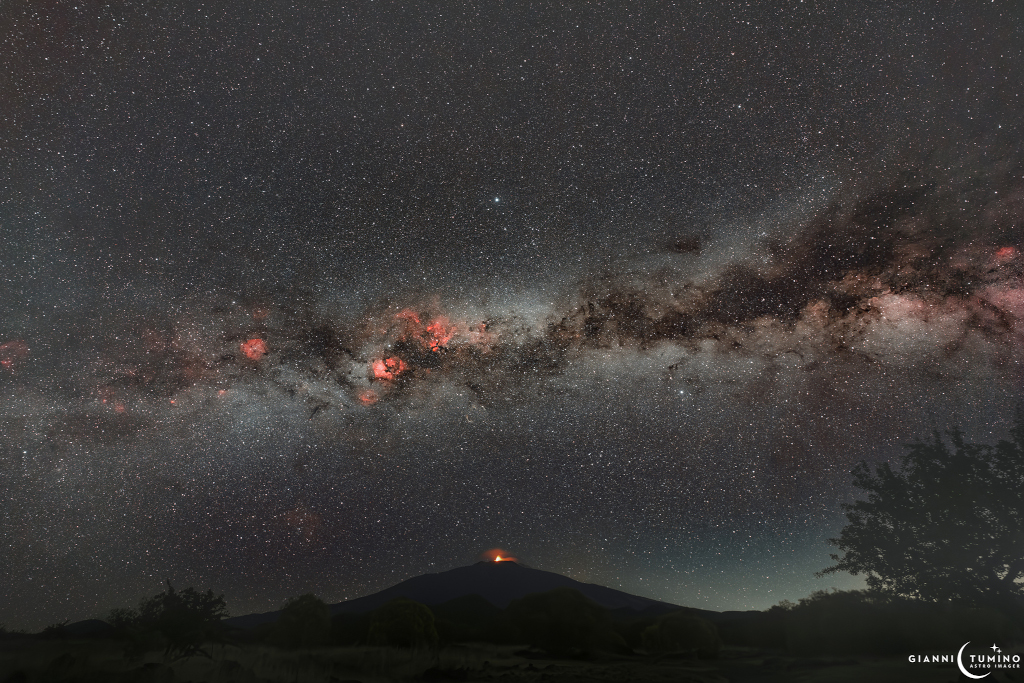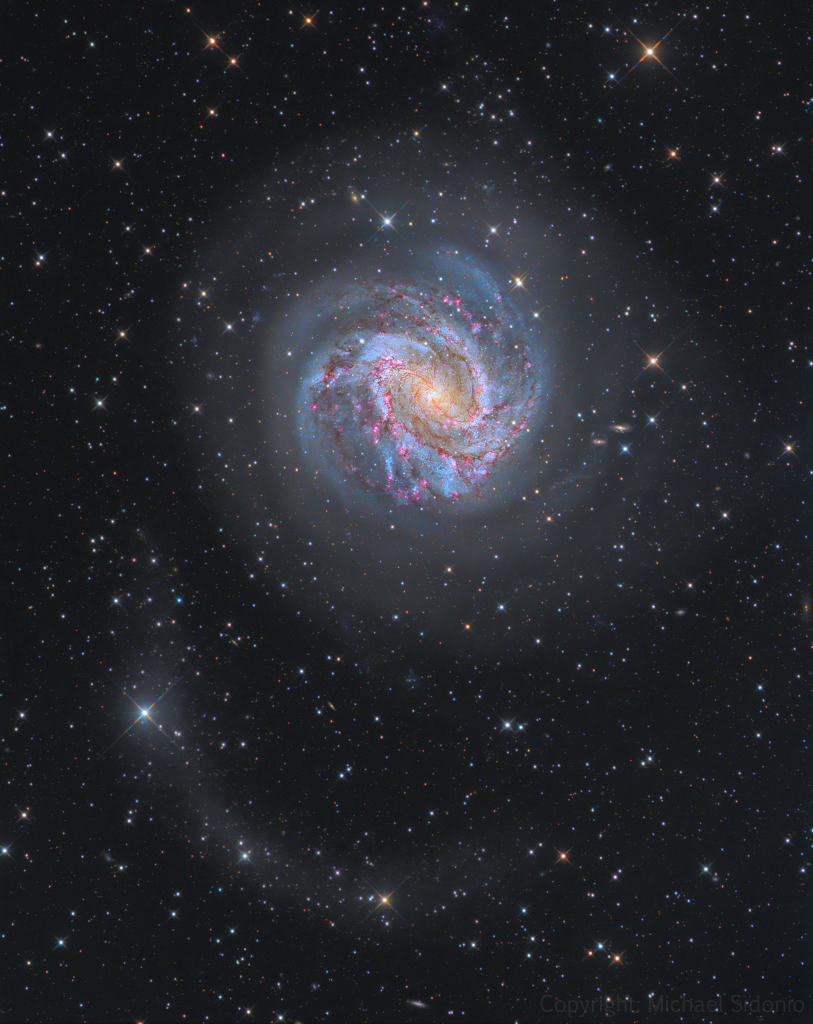2024 July 5
Nombre total de pages vues
05/07/2024
ASTRONOMY - Mount Etna Milky Way
04/07/2024
SANTé/MEDECINE - A la découverte de l'oreille - L'oreille externe
ASTRONOMY - A Beautiful Trifid
2024 July 4
Image Credit & Copyright: Jesús Carmona Guillén
Explanation: The beautiful Trifid Nebula is a cosmic study in contrasts. Also known as M20, it lies about 5,000 light-years away toward the nebula rich constellation Sagittarius. A star forming region in the plane of our galaxy, the Trifid does illustrate three different types of astronomical nebulae; red emission nebulae dominated by light from hydrogen atoms, blue reflection nebulae produced by dust reflecting starlight, and dark nebulae where dense dust clouds appear in silhouette. But the red emission region, roughly separated into three parts by obscuring dust lanes, is what lends the Trifid its popular name. Pillars and jets sculpted by newborn stars, above and right of the emission nebula's center, appear in famous Hubble Space Telescope close-up images of the region. The Trifid Nebula is about 40 light-years across. Too faint to be seen by the unaided eye, it almost covers the area of a full moon on planet Earth's sky.
03/07/2024
SANTé/MEDECINE - A la découverte de l'oreille - La structure de l'oreille
ASTRONOMY - M83: Star Streams and a Thousand Rubies
Image Credit & Copyright: Michael Sidonio
Explanation: Big, bright, and beautiful, spiral galaxy M83 lies a mere twelve million light-years away, near the southeastern tip of the very long constellation Hydra. About 40,000 light-years across, M83 is known as the Southern Pinwheel for its pronounced spiral arms. But the wealth of reddish star forming regions found near the edges of the arms' thick dust lanes, also suggest another popular moniker for M83, the Thousand-Ruby Galaxy. This new deep telescopic digital image also records the bright galaxy's faint, extended halo. Arcing toward the bottom of the cosmic frame lies a stellar tidal stream, debris drawn from massive M83 by the gravitational disruption of a smaller, merging satellite galaxy. Astronomers David Malin and Brian Hadley found the elusive star stream in the mid 1990s by enhancing photographic plates.
02/07/2024
SANTé/MEDECINE - Grands noms de la médecine - Wilhelm Röntgen
ASTRONOMY - NGC 602: Oyster Star Cluster
2024 July 2
Image Credit: X-ray: Chandra: NASA/CXC/Univ.Potsdam/L.Oskinova et al;
Optical: Hubble: NASA/STScI; Infrared: Spitzer: NASA/JPL-Caltech
Explanation: The clouds may look like an oyster, and the stars like pearls, but look beyond. Near the outskirts of the Small Magellanic Cloud, a satellite galaxy some 200 thousand light-years distant, lies this 5 million year old star cluster NGC 602. Surrounded by its birth shell of gas and dust, star cluster NGC 602 is featured in this stunning Hubble image, augmented in a rollover by images in the X-ray by the Chandra Observatory and in the infrared by Spitzer Telescope. Fantastic ridges and swept back gas strongly suggest that energetic radiation and shock waves from NGC 602's massive young stars have eroded the dusty material and triggered a progression of star formation moving away from the star cluster's center. At the estimated distance of the Small Magellanic Cloud, the featured picture spans about 200 light-years, but a tantalizing assortment of background galaxies are also visible in this sharp view. The background galaxies are hundreds of millions of light-years -- or more -- beyond NGC 602.
01/07/2024
ASTRONOMY - Time Spiral
2024 July 1
Illustration Credit: Pablo Carlos Budassi via Wikipedia
Explanation: What's happened since the universe started? The time spiral shown here features a few notable highlights. At the spiral's center is the Big Bang, the place where time, as we know it, began about 13.8 billion years ago. Within a few billion years atoms formed, then stars formed from atoms, galaxies formed from stars and gas, our Sun formed, soon followed by our Earth, about 4.6 billion years ago. Life on Earth begins about 3.8 billion years ago, followed by cells, then photosynthesis within a billion years. About 1.7 billion years ago, multicellular life on Earth began to flourish. Fish began to swim about 500 million years ago, and mammals because walking on land about 200 million years ago. Humans first appeared only about 6 million years ago, and made the first cities only about 10,000 years ago. The time spiral illustrated stops there, but human spaceflight might be added, which started only 75 years ago, and useful artificial intelligence began to take hold within only the past few years.
30/06/2024
SANTé/MEDECINE - Anatomie du coeur humain -
ASTRONOMY - Earthrise: A Video Reconstruction
2024 June 30
Video Credit: NASA, SVS, Apollo 8 Crew;
Lead Animator: Ernie Wright; (USRA); Music: C Major Prelude by Johann Sebastian Bach
Explanation: About 12 seconds into this video, something unusual happens. The Earth begins to rise. Never seen by humans before, the rise of the Earth over the limb of the Moon occurred about 55.5 years ago and surprised and amazed the crew of Apollo 8. The crew immediately scrambled to take still images of the stunning vista caused by Apollo 8's orbit around the Moon. The featured video is a modern reconstruction of the event as it would have looked were it recorded with a modern movie camera. The colorful orb of our Earth stood out as a familiar icon rising above a distant and unfamiliar moonscape, the whole scene the conceptual reverse of a more familiar moonrise as seen from Earth. To many, the scene also spoke about the unity of humanity: that big blue marble -- that's us -- we all live there. The two-minute video is not time-lapse -- this is the real speed of the Earth rising through the windows of Apollo 8. Seven months and three missions later, Apollo 11 astronauts would not only circle Earth's moon, but land on it.
ASTRONOMY - M1: The Crab Nebula
2025 December 29 M1: The Crab Nebula Image Credit & Copyright: Alan Chen Explanation: This is the mess that is left when a star explo...

-
2022 September 26 All the Water on Planet Earth Illustration Credit: Jack Cook, Adam Nieman, Woods Hole Oceanographic Institution ; Data ...
-
2025 May 11 The Surface of Venus from Venera 14 Image Credit: Soviet Planetary Exploration Program , Venera 14 ; Processing & Copyri...








